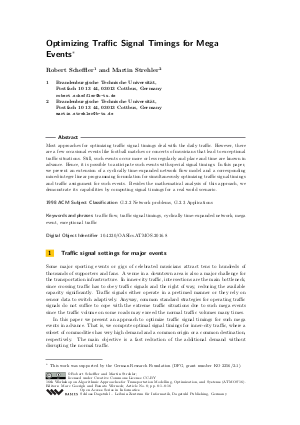Optimizing Traffic Signal Timings for Mega Events
Authors Robert Scheffler, Martin Strehler
-
Part of:
Volume:
16th Workshop on Algorithmic Approaches for Transportation Modelling, Optimization, and Systems (ATMOS 2016)
Part of: Series: Open Access Series in Informatics (OASIcs)
Part of: Conference: Symposium on Algorithmic Approaches for Transportation Modelling, Optimization, and Systems (ATMOS) - License:
 Creative Commons Attribution 3.0 Unported license
Creative Commons Attribution 3.0 Unported license
- Publication Date: 2016-08-24
File

PDF
OASIcs.ATMOS.2016.8.pdf
- Filesize: 0.5 MB
- 16 pages
Document Identifiers
Subject Classification
Keywords
- traffic flow
- traffic signal timings
- cyclically time-expanded network
- mega event
- exceptional traffic
Metrics
- Access Statistics
-
Total Accesses (updated on a weekly basis)
0PDF Downloads0Metadata Views
Abstract
Most approaches for optimizing traffic signal timings deal with the daily traffic. However, there are a few occasional events like football matches or concerts of musicians that lead to exceptional traffic situations. Still, such events occur more or less regularly and place and time are known in advance. Hence, it is possible to anticipate such events with special signal timings. In this paper, we present an extension of a cyclically time-expanded network flow model and a corresponding mixed-integer linear programming formulation for simultaneously optimizing traffic signal timings and traffic assignment for such events. Besides the mathematical analysis of this approach, we demonstrate its capabilities by computing signal timings for a real world scenario.
Cite As Get BibTex
Robert Scheffler and Martin Strehler. Optimizing Traffic Signal Timings for Mega Events. In 16th Workshop on Algorithmic Approaches for Transportation Modelling, Optimization, and Systems (ATMOS 2016). Open Access Series in Informatics (OASIcs), Volume 54, pp. 8:1-8:16, Schloss Dagstuhl – Leibniz-Zentrum für Informatik (2016)
https://doi.org/10.4230/OASIcs.ATMOS.2016.8
BibTex
@InProceedings{scheffler_et_al:OASIcs.ATMOS.2016.8,
author = {Scheffler, Robert and Strehler, Martin},
title = {{Optimizing Traffic Signal Timings for Mega Events}},
booktitle = {16th Workshop on Algorithmic Approaches for Transportation Modelling, Optimization, and Systems (ATMOS 2016)},
pages = {8:1--8:16},
series = {Open Access Series in Informatics (OASIcs)},
ISBN = {978-3-95977-021-7},
ISSN = {2190-6807},
year = {2016},
volume = {54},
editor = {Goerigk, Marc and Werneck, Renato F.},
publisher = {Schloss Dagstuhl -- Leibniz-Zentrum f{\"u}r Informatik},
address = {Dagstuhl, Germany},
URL = {https://drops.dagstuhl.de/entities/document/10.4230/OASIcs.ATMOS.2016.8},
URN = {urn:nbn:de:0030-drops-65323},
doi = {10.4230/OASIcs.ATMOS.2016.8},
annote = {Keywords: traffic flow, traffic signal timings, cyclically time-expanded network, mega event, exceptional traffic}
}
Author Details
References
-
R. E. Allsop. Selection of offsets to minimize delay to traffic in a network controlled by fixed-time signals. Transportation Science, pages 1-13, 1968.

-
R. E. Allsop and J. A. Charlesworth. Traffic in a signal-controlled road network: An example of different signal timings inducing different routeings. Traffic Eng. Control, 18(5):262-265, 1977.

-
S.-W. Chiou. Joint optimization for area traffic control and network flow. Computers and Operations Research, 32:2821-2841, 2005.

-
L. R. Ford and D. R. Fulkerson. Maximal flow through a network. Canadian Journal of Mathematics, 8:399-404, 1956.

-
L. R. Ford and D. R. Fulkerson. Flow in Networks. Princeton University Press, Princeton, 1962.

-
D. Grether. Extension of a multi-agent transport simulation for traffic signal control and air transport systems. Phd thesis, TU Berlin transport engineering, 2014.

-
D. Grether, J. Bischoff, and K. Nagel. Traffic-actuated signal control: Simulation of the user benefits in a big event real-world scenario. In Proceedings of the 2nd International Conference on Models and Technologies for Intelligent Transportation Systems, Leuven, Belgium, 2011.

-
E. Köhler and M. Strehler. Traffic signal optimization using cyclically expanded networks. In T. Erlebach and M. Lübbecke, editors, Proceedings of the 10th ATMOS, OpenAccess Series in Informatics (OASIcs), 2010.

-
E. Köhler and M. Strehler. Combining static and dynamic models for traffic signal optimization - inherent load-dependent travel times in a cyclically time-expanded network model. Procedia - Social and Behavioral Sciences, 54(0):1125 - 1134, 2012.

- E. Köhler and M. Strehler. Traffic signal optimization using cyclically expanded networks. Networks, 65(3):244-261, 2015. URL: http://dx.doi.org/10.1002/net.21601.
-
P. Koonce, L. Rodegerdts, K. Lee, S. Quayle, S. Beaird, C. Braud, J. Bonneson, P. Tarnoff, and T. Urbanik. Traffic Signal Timing Manual. Report Number FHWA-HOP-08-024. Federal Highway Administration, 2008.

-
S. Lämmer. Reglerentwurf zur dezentralen Online-Steuerung von Lichtsignalanlagen in Straßennetzwerken. PhD thesis, Technische Universität Dresden, 2007. (In German).

-
S. Lämmer. Stabilitätsprobleme vollverkehrsabhängiger Lichtsignalsteuerungen. Technical report, Technische Universität Dresden, 2009. (In German).

-
P. Li, P. Mirchandani, and X. Zhou. Solving simultaneous route guidance and traffic signal optimization problem using space-phase-time hypernetwork. Transportation Research Part B, 81(1):103-130, 2015.

-
J. D. C. Little. The synchronizing of traffic signals by mixed-integer linear programming. Operations Research 14, pages 568-594, 1966.

-
J. T. Morgan and J. D. C. Little. Synchronizing traffic signals for maximal bandwidth. Journal of the Operations Research Society of America, 12(6):896-912, 1964.

-
D. I. Robertson. TRANSYT method for area traffic control. Traffic Engineering &Control, 10:276 - 281, 1969.

-
M. Rubert and L. da Silva Portugal. Strategies for transport during sports mega events and their degree of importance. In Proceedings of the XVI Pan-American Conference of Traffic and Transportation Engineering and Logistics, Lisbon, 2010.

-
M. Smith. Bilevel optimisation of prices and signals in transportation models. In Mathematical and Computational Models for Congestion Charging, pages 159-200. Springer Science+Business Media, 2006.

-
M. van den Berg, B. D. Schutter, J. Hellendoorn, and A. Hegyi. Influencing route choice in traffic networks: a model predictive control approach based on mixed-integer linear programming. In 17th IEEE International Conference on Control Applications, pages 299-304, 2008.

